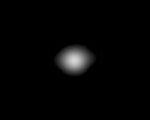Adrastea (moon)
Adrastea or Jupiter XV, is the second closest moon to Jupiter. It was found by David C. Jewitt and G. Edward Danielson in Voyager 2 probe photographs taken in 1979 and received the designation S/1979 J 1.[5][6] In 1983, it was named after the mythological Adrastea,[7] who was a daughter of Jupiter and Ananke.
 Image of Adrastea taken by Galileo's solid state imaging system between November 1996 and June 1997. | |
| Discovery | |
|---|---|
| Discovered by | David C. Jewitt G. Edward Danielson |
| Discovery date | July 8, 1979 |
| Orbital characteristics | |
Mean orbit radius | 129,000 km[1][2] |
| Eccentricity | 0.0015[1][2] |
| 0.29826 d (7 h 9.5 min)[1][2] | |
Average orbital speed | 31.378 km/s[3] |
| Inclination | 0.03° (to Jupiter's equator)[1][2] |
| Satellite of | Jupiter |
| Physical characteristics | |
| Dimensions | 20×16×14 km[4] |
Mean radius | 8.2 ± 2.0 km[4] |
| Volume | ~2,345 km³[3] |
| Mass | ~2×1015 kg[3] |
Mean density | 0.86 g/cm³ (assumed) |
| ~0.002 m/s² (0.0004 g)[3] | |
| ~0.008 km/s[3] | |
| synchronous | |
| zero[4] | |
| Albedo | ~0.1 ± 0.045[4] |
| Temperature | ~122 K |
Adrastea was the first moon to be found from images taken by an interplanetary spacecraft, rather than through telescopic photography.
Physical characteristics
changeAdrastea is non-spherical and measures 20x16x14 km³ across.[4] What Adrastea is made of and the mass of Adrastea are not known, but assuming that its mean density is like that of Amalthea (~0.86 g/cm³)[8] its mass can be estimated at ~2×1015 kg. Amalthea's density implies that moon is composed of water ice with a porosity of 10-15%, and Adrastea may be similar.[8]
No surface details of Adrastea are known, due to the low resolution of available images.[4]
Orbit
changeAdrastea is the smallest and second closest member of the closer moons to Jupiter. It orbits Jupiter at ~129,000 km (1.806 Jupiter radii) within the planet's Main Ring. The orbital eccentricity of ~0.0015 and inclination of ~ 0.03° relative to the equator of Jupiter are very small.[2]
Exploration
changeAdrastea was found in Voyager 1 and 2 images, but appeared only as a dot.[6] The Galileo spacecraft was able to see its shape, but the images remain poor.[4]
References
change- ↑ 1.0 1.1 1.2 1.3 Evans, M. W.; Porco, C. C.; Hamilton, D. P. (2002). "The Orbits of Metis and Adrastea: The Origin and Significance of their Inclinations". Bulletin of the American Astronomical Society. 34: 883. Bibcode:2002DPS....34.2403E.
- ↑ 2.0 2.1 2.2 2.3 2.4 Burns, J.A.; Simonelli, D.P. & Showalter, M.R. et al. (2004), "Jupiter’s Ring-Moon System", in Bagenal, F.; Dowling, T. E.; McKinnon, W. B., Jupiter: The planet, Satellites and Magnetosphere, Cambridge University Press
- ↑ 3.0 3.1 3.2 3.3 3.4 Calculated on the basis of other parameters
- ↑ 4.0 4.1 4.2 4.3 4.4 4.5 4.6 Thomas, P.C.; Burns, J.A.; Rossier, L.; Simonelli, D.; Veverka, J.; Chapman, C.R.; Klaasen, K.; Johnson, T.V.; Belton, M.J.S. (1998). "The Small Inner Satellites of Jupiter". ICARUS. 135 (2): 360–371. Bibcode:2000Icar..147..353S. doi:10.1006/icar.1998.5976.
- ↑ IAUC 3454: Editorial Notice 1980 February 25 (discovery)
- ↑ 6.0 6.1 Jewitt, David C.; Danielson, G. Edward; Synnott, Stephen P. (1979). "Discovery of a New Jupiter Satellite". Science. 206 (4421): 951. doi:10.1126/science.206.4421.951. PMID 17733911. S2CID 6391249.
- ↑ IAUC 3872: Satellites of Jupiter and Saturn 1983 September 30 (naming the moon)
- ↑ 8.0 8.1 Anderson, John D.; Johnson, Torrence V.; Schubert, Gerald; Asmar, Sami; Jacobson, Robert A.; Johnston, Douglas; Lau, Eunice L.; Lewis, George; Moore, William B.; Taylor, Anthony; Thomas, Peter C.; Weinwurm, Gudrun (2005). "Amalthea's Density Is Less Than That of Water". Science. 308 (5726): 1291–1293. Bibcode:2005Sci...308.1291A. doi:10.1126/science.1110422. PMID 15919987. S2CID 924257.
Other websites
change- Adrastea Profile Archived 2013-03-17 at the Wayback Machine by NASA's Solar System Exploration